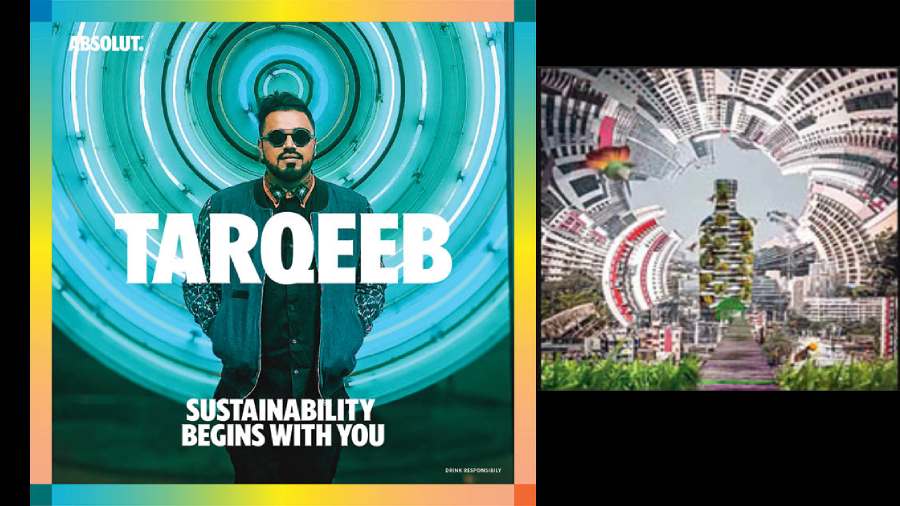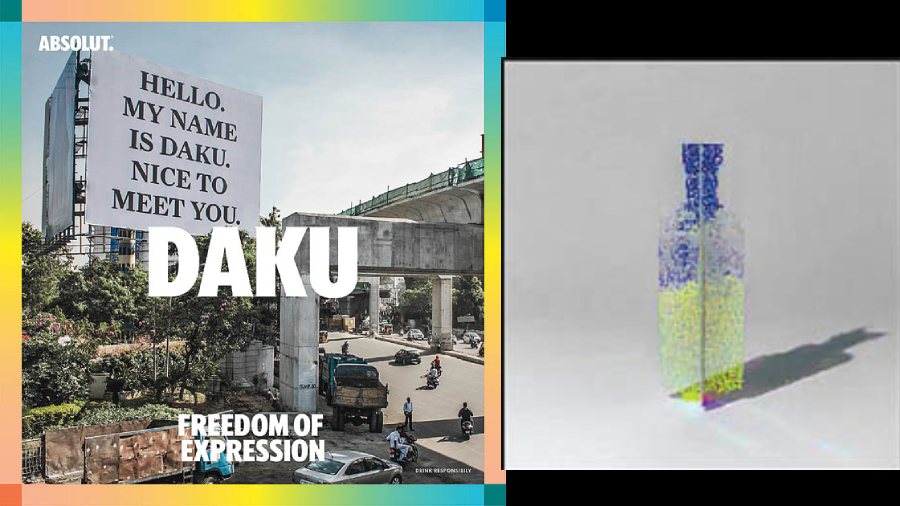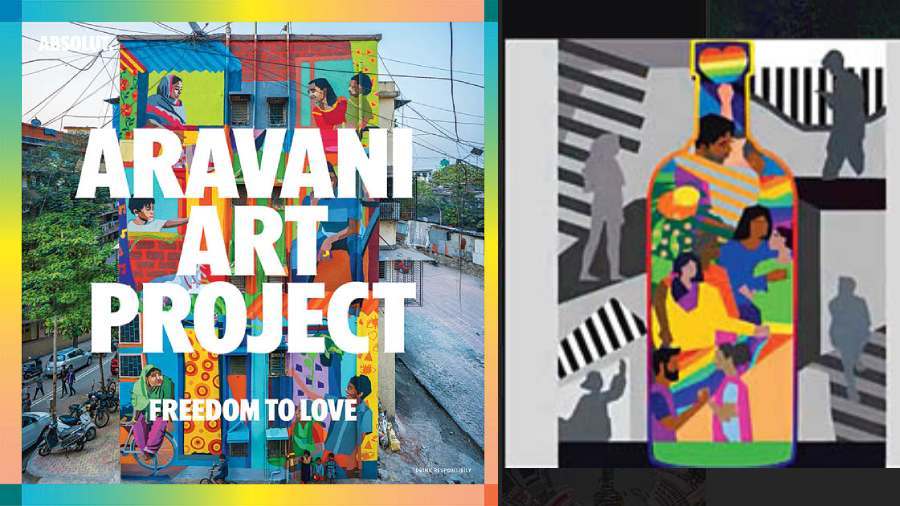What was the idea and inspiration behind your artwork for Absolut Creative Commune?
Daku: The idea behind my work for Absolut Creative Commune was to work with different languages and scripts of India together and mash them up in such a way that they create and look united at the same time as a freedom of expression of these scripts. When the sun falls on it, you see the different colours of shadows on the ground merging with you, with each other, just like all cultures.
Aravani Art Project: We are thrilled to collaborate with a brand like Absolut, which stands for a more inclusive world, an open world without biases. The artwork we created has gone through various renditions, but we emerged with something that is very effective and celebrated ‘LOVE IS LOVE’. Within the concept of being free and learning to break the stereotypical way to love, lies an endless ocean of freedom. It revisits the idea of having no boundaries, no conditions and no strings attached. To live free and to celebrate who you are. To love who you want. We spend so much time chasing an idea that we ignore what’s in front of us. Love opens a whole new way of looking at things. Friendship is the most sacred form of love.
Love between two men or two women is sacred. We make homes out of people because of love. Our decision to love and whom to love is an act of freedom. It is in freedom that we thrive and bloom. Reminds us why we are here. Being alive is the condition. Friendship is medicine. Queer friendship and love give the reassurance of love with no condition, boundaries, gender and colour. Queer friendship makes love real and instills a deep and resonant sense of hope, like we can change the world because look at how we’ve changed ourselves and each other.
The idea was to cohesively and visually be able to depict the different ways of loving and being. We are all still unlearning and relearning that ‘love’ is not necessarily just heteronormative and that we should have the freedom and fearlessness to celebrate all forms of ‘love’.

Khyati Trehan: Having lived across countries, working with Absolut Creative Commune around the theme of global identity was a fitting pick. In a world where societies are fractured and divisive forces are stronger than ever, it’s easy to forget that we are more in common. I was inspired by imagining a world where differences are brought together. My abstract virtual kinetic installation celebrates our diverse layers and comes alive with colour while pivoting around a common centre.
Osheen Siva: The collaboration with Absolut Creative Commune was inspired by the need for equal rights and representation. The artwork exemplifies the importance of gender equality and to live in an inclusive and progressive society.
Tarqeeb: The idea behind the artwork for Absolut Creative Commune was to highlight what a symbiotic relationship between urban spaces and nature would look like. I took inspiration from my city and more specifically from the park behind my house. This park underwent a complete transformation during the lockdown and became a beautiful ecosystem that enabled birds and plants to thrive. The vegetation completely took over the park and it was reclaimed by nature. This inspired me to imagine a world that prioritises the integration of nature into our environment design and daily life to achieve sustainable living.
How do you see life... bottle half full or empty?
Daku: I see it in balance.
Aravani Art Project: Since this question matters to the entire collective, it is a bit of both. Who are we kidding? We live in a world full of hope, dreams and goodness, but at the same time the reality kicks in too sometimes.
Khyati Trehan: Half full, but without glossing over the half empty..

Osheen Siva: Both! I’m grateful for what I have, but am always striving for more.
Tarqeeb: I feel I usually don’t over-analyse the bottle because to me the bottle is as full as it is empty. Although my art usually makes me take a definitive stand in which I oscillate between the bottle sometimes being half full and sometimes being half empty.
What is your favourite medium?
Daku: My favourite medium is time and I like to play with shadows. Time and shadows go hand in hand. Occasionally I also like to play with people’s minds, a little bit.
Aravani Art Project: We love big walls. We love to paint walls, engage with communities, celebrate and preach that art is for all and interestingly, a new discovery in terms of development in the arts has been theatre. We really are taking it slow but looking forward to exploring more ways.
Khyati Trehan: I’m drawn to 3D digital art because it feels like magic. 3D equips you with being able to whip up spaces and objects mimicking reality, and gives the power to mould them like clay.
Osheen Siva: This is a tough question to answer. I love different mediums for different reasons but this year I want to focus on doing more of 2D animation and mural projects.

Tarqeeb: Digital is my favourite medium. I started out with making digital collages on my phone and it’s still an integral part of my workflow and execution.
Your favourite artist?
Daku: My favourite artist keeps changing but currently, I am loving what French artist JR is doing.
Aravani Art Project: This is perhaps the toughest question to answer. But we are truly inspired by the beautiful folk art that exists in India. Folk art binds storytelling, nature and art together so beautifully.
Khyati Trehan: Hard to pick only one but at the moment, I’m digging Karan Singh’s animated pieces. He has a unique way of using colour and pattern to play with human perception.
Osheen Siva: So many! Some of them are James Jean, Chitra Ganesh, Charles Burns, Jack Kirby, Jodorowsky.
Tarqeeb: I have many favourite artists, but Shepard Fairey is someone whose art and activism has inspired and impacted me since a very early age.

What is your philosophy as an artist?
Daku: My philosophy as an artist is to make people realise or notice things that are obvious but then when it’s presented in a different form, people notice or start to look at it differently. That’s how I look at shadows. I look at shadows as another medium to paint and I paint with shadows at the same time I work with the time and I like the idea of time about how we are all in this time together and how time changes everything.
Aravani Art Project: We are finding magical ways to engage the transgender community to come out in the public spaces and feel confident, safe and to one which they belong to. Our intention is to make these interventions with spaces where the transgender community, live/survive and work out of, develop a sense of responsibility and self-worth. We are able to leverage art to reach out to as many people as possible within the local communities and intertwine their journey into creating awareness, rehabilitation and inclusion, artistically. The immediate circle of people who support them and care for them become participants organically, giving us the liberty to go deeper into the conversations with the curious lookers-on.
Khyati Trehan: My art practice is a pursuit in making the intangible tangible.
Osheen Siva: I try to be true and unapologetic with what I create and put out through my practice.
Tarqeeb: I think my philosophy with art has always been to look for points of contact between the normal and the unusual and to break the shackles of appropriateness and cultural obligation by creating work that makes you question the rationale behind what we may refer to as normal











